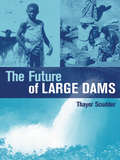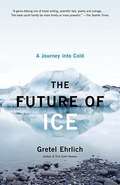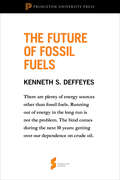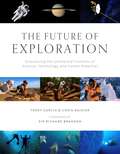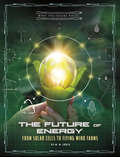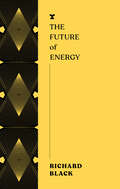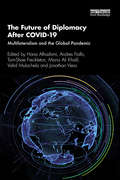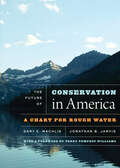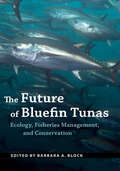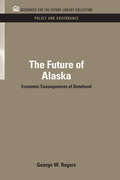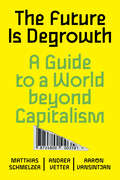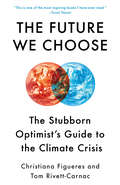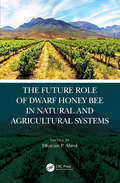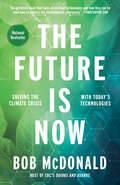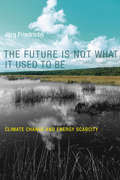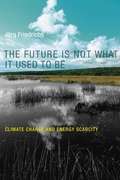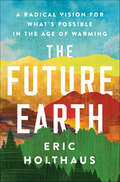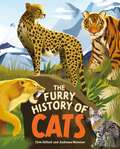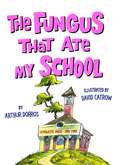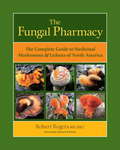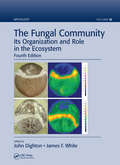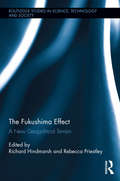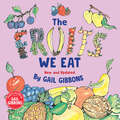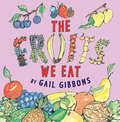- Table View
- List View
The Future of Large Dams: "Dealing with Social, Environmental, Institutional and Political Costs"
by Thayer Ted ScudderViewed by some as symbols of progress and by others as inherently flawed, large dams remain one of the most contentious development issues on Earth. Building on the work of the now defunct World Commission on Dams, Thayer Scudder wades into the debate with unprecedented authority. Employing the Commission's Seven Strategic priorities, Scudder charts the 'middle way' forward by examining the impacts of large dams on ecosystems, societies and political economies. He also analyses the structure of the decision-making process for water resource development and tackles the highly contentious issue of dam-induced resettlement, illuminated by a statistical analysis of 50 cases.
The Future of Indian and Federal Reserved Water Rights: The Winters Centennial
by Barbara Cosens Judith V. RoysterOn January 6, 1908, the Supreme Court ruled that when land is set aside for the use of Indian tribes, that reservation of land includes reserved water rights. The Winters Doctrine, as it has come to be known, is now a fundamental principle of both federal Indian law and water law and has expanded beyond Indian reservations to include all federal reservations of land. Ordinarily, there would not be much to say about a one hundred-year-old Supreme Court case. But while its central conclusion that a claim to water was reserved when the land was reserved for Indians represents a commitment to justice, the exact nature of that commitment-its legal basis, scope, implications for non-Indian water rights holders, the purposes for and quantities of water reserved, the geographic nexus between the land and the water reserved, and many other details of practical consequence-has been, and continues to be, litigated and negotiated. In this detailed collection of essays, lawyers, historians, and tribal leaders explore the nuances of these issues and legacies.
The Future of Ice: A Journey into Cold
by Gretel EhrlichTo understand the complex, primal nature of cold, Ehrlich traveled to extreme points, from Tierra del Fuego to the Arctic circle. In this volume she reports on her experiences of the many expressions of cold--wind, water, snow and ice--and describes the history of these elements and of ocean currents and weather cycles. She attempts to uncover through her experiences the quintessential connection between humans and the physical world. Annotation ©2004 Book News, Inc. , Portland, OR (booknews. com)
The Future of Fossil Fuels: From Hubbert's Peak (Princeton Shorts #4)
by Kenneth S. DeffeyesAs debates about the effects of fossil fuels on our climate and foreign policy intensify, the question of just how much longer we can depend on this finite source of energy becomes more and more pressing. This selection from Hubbert's Peak, the leading book on the limits of our oil supply, forecasts what the future will bring for fossil fuels and what the alternatives are likely to be. Princeton Shorts are brief selections excerpted from influential Princeton University Press publications produced exclusively in eBook format. They are selected with the firm belief that while the original work remains an important and enduring product, sometimes we can all benefit from a quick take on a topic worthy of a longer book. In a world where every second counts, how better to stay up-to speed on current events and digest the kernels of wisdom found in the great works of the past? Princeton Shorts enables you to be an instant expert in a world where information is everywhere but quality is at a premium. The Future of Fossil Fuels does just that.
The Future of Exploration: Discovering the Uncharted Frontiers of Science, Technology, and Human Potential
by Chris Rainier Terry GarciaAt this very moment, explorers in some of the most remote and dangerous places on earth, from the deepest parts of the ocean, to the highest mountains, and to outer space are enduring unimaginable hardships to expand our knowledge and save what is truly important.Join former National Geographic Executive Vice President and Chief Science Officer Terry Garcia and nature and cultural photographer Chris Rainier, a National Geographic Explorer, on a journey with some of the world&’s most renowned and respected explorers, scientists, astronauts, visionaries, thinkers, and authors as they discuss and share their insights about what motivates them, what is left to explore, and why we should care in The Future of Exploration. Exploration is as old as humankind, but there are still surprises that await us. With technology opening doors that once seemed permanently closed, the twenty-first century will be the greatest age of exploration in our history. Accompanied with awe-inspiring photography, each contributor shares their personal achievements and insight into what the future of exploration looks like from their respective fields, the challenges we face, and possible solutions. Whether delving into the terrestrial, oceanic, or cosmic frontiers, embark on a journey into the uncharted future and be inspired yourself to be a part of the future of exploration.
The Future of Energy: From Solar Cells to Flying Wind Farms (What the Future Holds)
by M. M. EbochOur world runs on energy! But traditional fossil fuels are doing great damage to the environment, and they will eventually run out. How might solar, water, wind and geothermal power come to our rescue? Readers can discover how different the world could look in the future with energy sources that are clean and renewable.
The Future of Energy (The FUTURES Series)
by Richard BlackHow will the world produce more, cleaner energy? Climate communications expert Richard Black sets out a vision for the future which could benefit us all.Coal, oil and gas provide four-fifths of the energy that powers our modern world. But continuing to burn them will mean wrecking the only planet we have. Is there a way out?In The Future of Energy, journalist and analyst Richard Black argues that there is, and that the transition to a clean energy world is already underway. He shows that with just five key technologies we can replace the burning of fossil fuels almost entirely, as quickly as society decides.Doing so will do much more than halt climate change. The transition will bring cheaper energy, cleaner air, and more jobs. It will remove some of the factors behind oppression, injustice, and conflict. And it is supported by an overwhelming majority of the world&’s population. This may not be the story of energy that you hear most about from politicians, business leaders and journalists, but it is the one that matters.
The Future of Diplomacy After COVID-19: Multilateralism and the Global Pandemic
by Hana AlhashimiThis book considers the impact of the COVID-19 pandemic on international diplomacy, and the challenges and opportunities it presents for the future of multilateralism. Global cooperation and solidarity are central to responding to and mitigating the health and socio-economic effects of the COVID-19 pandemic, yet, to many, this was slow to mobilize and lacking in political leadership. This book takes a practical look at the lessons learned from the period spanning the World Health Organization’s first declaration of a public health emergency of international concern in January 2020, to the commemoration of the 75th Anniversary of the United Nations in October 2020. This timespan covers a critical period in which to consider key areas of diplomacy, covering a range of tools of global cooperation: multilateral diplomacy, the rule of law, sustainable development, economics and financing, digital governance, and peace and security. Each chapter in this book introduces readers to the current situation in their respective areas, followed by a constructive consideration of lessons learned from the pandemic’s impact on that field, and key recommendations for the future. The practical focus and future orientation is particularly important as the book injects pragmatism and guidance that will facilitate ‘building back better’ in COVID response plans, while creating space for continued focus on global commitments around sustainable development and the future of the UN. Written by a team of authors who have worked directly in International Public Policy and the establishment of global agendas at the United Nations, this book will be essential reading for professionals and policymakers involved in diplomatic roles, as well as students and scholars interested in the future of international relations, global governance and sustainable development.
The Future of Conservation in America: A Chart For Rough Water, With A Foreword By Terry Tempest Williams
by Terry Tempest Williams Gary E. Machlis Jonathan B. JarvisThis is a turbulent time for the conservation of America’s natural and cultural heritage. From the current assaults on environmental protection to the threats of climate change, biodiversity loss, and disparity of environmental justice, the challenges facing the conservation movement are both immediate and long term. In this time of uncertainty, we need a clear and compelling guide for the future of conservation in America, a declaration to inspire the next generation of conservation leaders. This is that guide—what the authors describe as “a chart for rough water.” Written by the first scientist appointed as science advisor to the director of the National Park Service and the eighteenth director of the National Park Service, this is a candid, passionate, and ultimately hopeful book. The authors describe a unified vision of conservation that binds nature protection, historical preservation, sustainability, public health, civil rights and social justice, and science into common cause—and offer real-world strategies for progress. To be read, pondered, debated, and often revisited, The Future of Conservation in America is destined to be a touchstone for the conservation movement in the decades ahead.
The Future of Bluefin Tunas: Ecology, Fisheries Management, and Conservation
by Barbara A. BlockThe most thorough and current account of scientific research on bluefin tunas—the largest, most sought-after tunas in the worldBluefin tunas are dominant keystone predators known for their impressive size, strength, endurance, and speed. Electronic tags have revealed that they can dive to great depths (over 6000 feet) and migrate vast distances—from frigid subpolar seas to warm tropical waters—for spawning. Prized for their rich taste and unique texture, bluefin tunas are also a worldwide commodity of great value. However, over the past few decades, overfishing throughout their range has led to significant population reductions.In The Future of Bluefin Tunas, Barbara A. Block brings together renowned bluefin experts from 15 different countries to share the latest information on the science, fisheries policy, and management decisions related to each of the three species within the Thunnus group—Atlantic, Pacific, and Southern. Synthesizing basic and applied research, the book delves into every aspect of these majestic fish, from their life history and genetic makeup to their ecology and migrations. Ichthyologists and marine scientists dedicated to the study of these fishes report on the latest stock assessments, explore the results of advances such as biologging and DNA sampling, and assess the potential of bluefin tuna aquaculture.The Future of Bluefin Tunas provides critical research findings to inform decisions that will impact tunas and the ocean ecosystems they affect. Scientists, fisheries managers, policymakers, and marine conservationists will take away key data from this timely volume to help them ensure these remarkable fish continue in perpetuity.
The Future of Alaska: Economic Consequences of Statehood (RFF Policy and Governance Set)
by George RogersThis book is both a discussion of key decisions Alaskans must make in coming years and a case study of problems of public finance and policy that accompany shifts in power. Originally published in 1962
The Future is Degrowth: A Guide to a World Beyond Capitalism
by Matthias Schmelzer Andrea Vetter Aaron VansintjanWe need to break free from the capitalist economy. Degrowth gives us the tools to bend its bars. Economic growth isn&’t working, and it cannot be made to work. Offering a counter-history of how economic growth emerged in the context of colonialism, fossil-fueled industrialization, and capitalist modernity, The Future Is Degrowth argues that the ideology of growth conceals the rising inequalities and ecological destructions associated with capitalism, and points to desirable alternatives to it.Not only in society at large, but also on the left, we are held captive by the hegemony of growth. Even proposals for emancipatory Green New Deals or postcapitalism base their utopian hopes on the development of productive forces, on redistributing the fruits of economic growth and technological progress. Yet growing evidence shows that continued economic growth cannot be made compatible with sustaining life and is not necessary for a good life for all.This book provides a vision for postcapitalism beyond growth. Building on a vibrant field of research, it discusses the political economy and the politics of a non-growing economy. It charts a path forward through policies that democratise the economy, &“now-topias&” that create free spaces for experimentation, and counter-hegemonic movements that make it possible to break with the logic of growth. Degrowth perspectives offer a way to step off the treadmill of an alienating, expansionist, and hierarchical system.A handbook and a manifesto, The Future Is Degrowth is a must-read for all interested in charting a way beyond the current crises.
The Future We Choose: Surviving the Climate Crisis
by Christiana Figueres Tom Rivett-CarnacClimate change: it is arguably the most urgent and consequential issue humankind has ever faced. How we address it in the next thirty years will determine the kind of world we will live in and will bequeath to our children and to theirs.In The Future We Choose, Christiana Figueres and Tom Rivett-Carnac--who led negotiations for the United Nations during the historic Paris Agreement of 2015--have written a cautionary but optimistic book about the world's changing climate and the fate of humanity. The authors outline two possible scenarios for our planet. In one, they describe what life on Earth will be like by 2050 if we fail to meet the Paris climate targets. In the other, they lay out what it will be like to live in a carbon neutral, regenerative world. They argue for confronting the climate crisis head-on, with determination and optimism. The Future We Choose presents our options and tells us what governments, corporations, and each of us can and must do to fend off disaster.
The Future Role of Dwarf Honey Bees in Natural and Agricultural Systems
by Dharam P. AbrolThe future role of dwarf honeybees in natural and agricultural systems provides multidisciplinary perspective about the different facets of dwarf honeybees. The role of dwarf honeybee Apis florea assumes utmost importance in the context of pollinator decline throughout the world threatening stability of ecosystems and global food security. Apis florea is a low land species of south Asia extending more to the west than other Asiatic Apis species. It is an important pollinator of crops in hot and dry agricultural plains. The book is first of its kind which deals in details on varied aspects of Apis florea biology, management, conservation strategies for protecting biodiversity and enhancing crop productivity. The book aims to promote a large, diverse, sustainable, and dependable bee pollinator workforce that can meet the challenge for optimizing food production well into the 21st century. Features: Apis florea provides source of livelihood in mountainous areas and marginal farmers. This book will for the first time present the beekeeping from the perspective of agricultural production and biodiversity conservation An excellent source of advanced study material for academics, researchers and students and programme planners Excellent pollinator of tropical and subtropical crops fruits vegetables etc less prone to diseases and enemies Covering the latest information on various aspects of Apis florea biology, this book brings the latest advances together in a single volume for researchers and advanced level students This book will be useful to pollination biologists, honeybee biologists in entomology departments, students, teachers, scientists of agriculture, animal behaviour, botany, conservation, biology, ecology, entomology, environmental biology, forestry, genetics, plant breeding, horticulture, toxicology, zoology, seed growers and seed agencies and shall serve as reference book for students, teachers, researchers, extension functionaries and policy planners.
The Future Is Now: Solving the Climate Crisis with Today's Technologies
by Bob McDonaldIs a global pandemic what it took to show us that saving our planet is possible?In the absence of motorized boats and gondolas, Venice&’s waters have returned to a sparkling blue color. Deer have been spotted roaming cities in Italy, and mountain goats recently took over a small seaside town in Wales. Taking advantage of the decreased boat traffic, whales have returned to roaming Vancouver&’s harbours. The absence of &“regular&” human activities has dramatically affected our environment. In this book, Bob McDonald turns his focus to global energy sources, and shows how the global shutdowns may have been exactly what we needed to show us that a greener future is achievable. This is not another &“wake-up call,&” and not another plea to heed the climate science. This is an exploration of the incredible technologies that our species can use to get out of the mess we&’ve made for ourselves. It is a work of immense optimism, to counteract the sense of doom that hangs over most discussions of the environment. Many alternative energy sources such as wind, solar, and geothermal have been available for decades—but they alone will not be enough. Additional power will come from small nuclear reactors the size of an office desk, and space-based solar power satellites with enormous mirrors that can capture sunlight, convert it to microwaves, and beam it to the ground to light up entire cities. Energy will be captured from waves, tides, and hydrogen. Vehicles will no longer have tailpipes that emit smog particles. Food will be sourced locally. Green technology is one of the fastest growing sectors of the economy, and will only continue to skyrocket as current products improve their performance and new products emerge. A new green age is upon us--let this book be your guide to the future.
The Future Is Not What It Used to Be: Climate Change and Energy Scarcity
by Jorg FriedrichsA hard look at the twin challenges of climate change and energy scarcity that examines historical precedents and allows no room for complacency.The future is not what it used to be because we can no longer rely on the comforting assumption that it will resemble the past. Past abundance of fuel, for example, does not imply unending abundance. Infinite growth on a finite planet is not possible. In this book, Jörg Friedrichs argues that industrial society itself is transitory, and he examines the prospects for our civilization's coming to terms with its two most imminent choke points: climate change and energy scarcity. He offers a thorough and accessible account of these two challenges as well as the linkages between them.Friedrichs contends that industrial civilization cannot outlast our ability to burn fossil fuels and that the demise of industrial society would entail cataclysmic change, including population decreases. To understand the social and political implications, he examines historical cases of climate stress and energy scarcity: devastating droughts in the ancient Near East; the Little Ice Age in the medieval Far North; the Japanese struggle to prevent “fuel starvation” from 1918 to 1945; the “totalitarian retrenchment” of the North Korean governing class after the end of Soviet oil deliveries; and Cuba's socioeconomic adaptation to fuel scarcity in the 1990s. He draws important lessons about the likely effects of climate and energy disruptions on different kinds of societies.The warnings of climate scientists are met by denial and inaction, while energy experts offer little guidance on the effects of future scarcity. Friedrichs suggests that to confront our predicament we must affirm our core values and take action to transform our way of life. Whether we are private citizens or public officials, complacency is not an option: climate change and energy scarcity are emerging facts of life.
The Future Is Not What It Used to Be
by Jörg FriedrichsThe future is not what it used to be because we can no longer rely on the comfortingassumption that it will resemble the past. Past abundance of fuel, for example, does not implyunending abundance. Infinite growth on a finite planet is not possible. In thisbook, Jrg Friedrichs argues that industrial society itself is transitory, and he examines theprospects for our civilization's coming to terms with its two most imminent choke points: climatechange and energy scarcity. He offers a thorough and accessible account of these two challenges aswell as the linkages between them. Friedrichs contends that industrialcivilization cannot outlast our ability to burn fossil fuels and that the demise of industrialsociety would entail cataclysmic change, including population decreases. To understand the socialand political implications, he examines historical cases of climate stress and energy scarcity:devastating droughts in the ancient Near East; the Little Ice Age in the medieval Far North; theJapanese struggle to prevent "fuel starvation" from 1918 to 1945; the "totalitarianretrenchment" of the North Korean governing class after the end of Soviet oil deliveries; andCuba's socioeconomic adaptation to fuel scarcity in the 1990s. He draws important lessons about thelikely effects of climate and energy disruptions on different kinds ofsocieties. The warnings of climate scientists are met by denial and inaction,while energy experts offer little guidance on the effects of future scarcity. Friedrichs suggeststhat to confront our predicament we must affirm our core values and take action to transform our wayof life. Whether we are private citizens or public officials, complacency is not an option: climatechange and energy scarcity are emerging facts of life.
The Future Earth: A Radical Vision for What's Possible in the Age of Warming
by Eric HolthausThe first hopeful book about climate change, The Future Earth shows readers how to reverse the short- and long-term effects of climate change over the next three decades.The basics of climate science are easy. We know it is entirely human-caused. Which means its solutions will be similarly human-led. In The Future Earth, leading climate change advocate and weather-related journalist Eric Holthaus (“the Rebel Nerd of Meteorology”—Rolling Stone) offers a radical vision of our future, specifically how to reverse the short- and long-term effects of climate change over the next three decades. Anchored by world-class reporting, interviews with futurists, climatologists, biologists, economists, and climate change activists, it shows what the world could look like if we implemented radical solutions on the scale of the crises we face. What could happen if we reduced carbon emissions by 50 percent in the next decade?What could living in a city look like in 2030?How could the world operate in 2040, if the proposed Green New Deal created a 100 percent net carbon-free economy in the United States?This is the book for anyone who feels overwhelmed by the current state of our environment. Hopeful and prophetic, The Future Earth invites us to imagine how we can reverse the effects of climate change in our own lifetime and encourages us to enter a deeper relationship with the earth as conscientious stewards and to re-affirm our commitment to one another in our shared humanity.
The Furry History of Cats (History of... #2)
by Clive GiffordRoarsome and awesome cats are amongst the most intriguing and much-loved mammals on the planet. With over 40 different species, this book looks at them all, from the smallest, cutest cats to the most powerful cats such as lions, tigers and jaguars.Discover how their fur is important in many different ways. See inside cats to reveal the features that give them their agile movement and hunting prowess. Learn about their paw-fect super senses. Travel back in time to discover the prehistoric sabre-toothed cats. Then discover what you can do to help look after cats at home and in the wild.The colourful and detailed illustrations from Andressa Meissner bring the cats vividly to life. The consultant is the curator of the Big Cat Sanctuary, a UK-based charity established to conserve wild cats globally
The Fungus That Ate My School
by Arthur DorrosWhile the students are home for spring vacation, the fungus they are growing in their classroom grows and grows and takes over the entire school.
The Fungal Pharmacy
by Robert Rogers Solomon P. WasserIn The Fungal Pharmacy, noted herbalist Robert Rogers introduces readers to more than 300 species of medicinal mushrooms and lichens found in North America. These fungi, Rogers explains, have the capacity to heal both the body and, through the process of myco-remediation, the planet itself. Throughout the book, he documents their success in optimizing the immune system and treating a wide range of acute and chronic diseases, including cardiovascular, respiratory, and liver problems, blood sugar disorders, cancer, and obesity.Entries discuss the mushroom or lichen's medicinal traits and properties, including active chemical components, preparation methods (including extracts, essences, and essential oils), and historical as well as modern-day usage. Two hundred full-color photos and thorough descriptions make identification easy for the reader. Rogers also delves into the cultural, religious, and literary significance of each mushroom, featuring fascinating tidbits about each one's etymology and history.
The Fungal Community: Its Organization and Role in the Ecosystem, Fourth Edition (Mycology)
by James F. White John Dighton"…a number of chapters provide excellent summaries of the modern methods available for studying fungal ecology, along with those more traditional methods that are still extremely valuable…overall it is a hugely valuable compendium of fungal ecology research. It is a must for the library shelf." -Lynne Boddy, Cardiff University, UK, Mycological Research, 2006"These 44 chapters are an excellent starting point for anyone interested in fungal communities, in the broadest sense of the term. It is a book for dipping into…may be the last comprehensive treatment of fungal communities before the molecular revolution."-Meriel Jones, University of Liverpool, UK, Microbiology Today "… the scope of the work is tremendous. … Excellent chapters providing overviews of methods … provide a snap shot of the current approaches used to understand fungal communities at several levels of organization. This book should probably be on the shelf of every student of mycology, and many ecologists too. For all students, this book should be a valuable resource and source of inspiration." -Daniel Henk, Imperial College Faculty of Medicine, London, in Inoculum, Vol. 59, No. 3, May 2008 "Thorough taxonomic and subject indices further aid the reader in navigating through multiple authors’ treatments of subjects of interest." - Anthony Amend, Department of Botany, University of Hawaii at Manoa in Economic Botany, V. 61 In all subjects in science, new findings and the use of new technologies allow us to develop an ever-greater understanding of our world. Expanded and updated coverage in the fourth edition includes: Adds new sections on Integrating Genomics and Metagenomics into Community Analysis, Recent Advances in Fungal Endophyte Research, Fungi in the Built Environment, and Fungal Signaling and Communication Includes a broader treatment of fungal communities in natural ecosystems with in-depth coverage of fungal adaptations to stress and conservation Expands coverage of the influence of climate change on fungi and the role of fungi in organically polluted ecosystems Includes contributions from scientists from 20 nations to illustrate a true global approach for bridging gaps between ecological concepts and mycology
The Fukushima Effect: A New Geopolitical Terrain (Routledge Studies in Science, Technology and Society)
by Richard Hindmarsh Rebecca PriestleyThe Fukushima Effect offers a range of scholarly perspectives on the international effect of the Fukushima Daiichi nuclear meltdown four years out from the disaster. Grounded in the field of science, technology and society (STS) studies, a leading cast of international scholars from the Asia-Pacific, Europe, and the United States examine the extent and scope of the Fukushima effect. The authors each focus on one country or group of countries, and pay particular attention to national histories, debates and policy responses on nuclear power development covering such topics as safety of nuclear energy, radiation risk, nuclear waste management, development of nuclear energy, anti-nuclear protest movements, nuclear power representations, and media representations of the effect. The countries featured include well established ‘nuclear nations’, emergent nuclear nations and non-nuclear nations to offer a range of contrasting perspectives. This volume will add significantly to the ongoing international debate on the Fukushima disaster and will interest academics, policy-makers, energy pundits, public interest organizations, citizens and students engaged variously with the Fukushima disaster itself, disaster management, political science, environmental/energy policy and risk, public health, sociology, public participation, civil society activism, new media, sustainability, and technology governance.
The Fruits We Eat (New & Updated)
by Gail GibbonsFrom #1 science writer for kids Gail Gibbons, learn everything about the delicious fruits you eat with this new and updated edition.Berries, apples, melons, and grapes; oranges, grapefruits, bananas -- yum! This scrumptious, updated picture book, a companion to The Vegetables We Eat, offers youngsters an inviting, information-packed cornucopia of favorite fruits.Gail Gibbons combines a clear, simple text with her signature illustrations to present fruit facts galore: the parts of fruits, where and how they grow, harvesting, processing, where to buy them, and how to enjoy them as part of a healthy diet.
The Fruits We Eat
by Gail GibbonsBerries, apples, melons, and grapes; oranges, grapefruits, bananas -- yum! This scrumptious picture book, a companion to The Vegetables We Eat, offers youngsters an inviting, information-packed cornucopia of favorite fruits. Gail Gibbons combines a clear, simple text with her signature illustrations to present fruit facts galore: the parts of fruits, where and how they grow, harvesting, processing, where to buy them, and how to enjoy them as part of a healthy diet.
